The cost of replacement ewes at joining at approximately 18 months of age is equivalent to 25% of the value of lamb carcase output produced during their lifetime. It is estimated that the ewe replacement rate for the national lowland flock is approximately 22% (National Farm Survey).
Replacement ewes normally join breeding flocks at 18 months of age with the intention of producing their first lambs at 24 months. Two ways of reducing replacement cost are, firstly, to increase longevity and thus the number of litters produced, and, secondly, to increase litter size and thus the number of lambs weaned per ewe joined to the ram.
Athenry study
An ongoing study at Athenry was designed to evaluate the effects of age at first lambing and ewe genotype [=75% Suffolk, Suffolk×Belclare, purebred Belclare] on the lifetime performance of ewes. Suffolk was chosen as over half of the national flock comprise Suffolk types while the Belclare was chosen because of its proven high productivity.
Half of the ewe lambs, within each genotype, were joined with rams to produce their first litter at one year of age while the remainder were joined to produce their first litter at two years of age. To avoid maternal and terminal breed confounding effects and to maximise hybrid vigour in the lambs, Charollais sires were used.
All ewe lambs in this study were managed as one flock from four months of age until time of joining with a ram. Following joining, all ewes were managed as one flock until one month post-housing (early January).
From early January to six weeks prior to lambing, ewe lambs which were joined were offered concentrate supplementation (250g/day) to meet pregnancy requirements and enable the ewes to continue to grow. During the last six weeks of pregnancy, ewes carrying singles, twins and triplets received 18kg, 26kg and 33kg concentrate, respectively.
The ewe lambs that were to be joined for the first time to lamb at two years of age received grass silage as the sole diet during their first winter housing period. When the ewe lambs that lambed at one year of age were weaned (at 15 months) they were managed as one flock with those that had not been joined the previous autumn. At this stage of the study, results from lambing up to four years of age are available for all animals.
Ewe lamb mating management
The “ram effect” can be used to induce ewes and ewe lambs to start cycling provided they are sufficiently close to the time of onset of normal cyclicity. For the “ram effect” to work, the ewes should not have been in contact (sight or smell) with rams for the previous month.
The “ram effect” was used on ewe lambs at Athenry and the procedure used is summarised in Table 1. Fertile rams were introduced to the flock 14 days after the rams used to induce the “ram effect” were first introduced to cover ewes with short cycles and ewes that were already cyclic at the time of ram introduction. Expected peak mating times are four and nine days after fertile ram introduction.
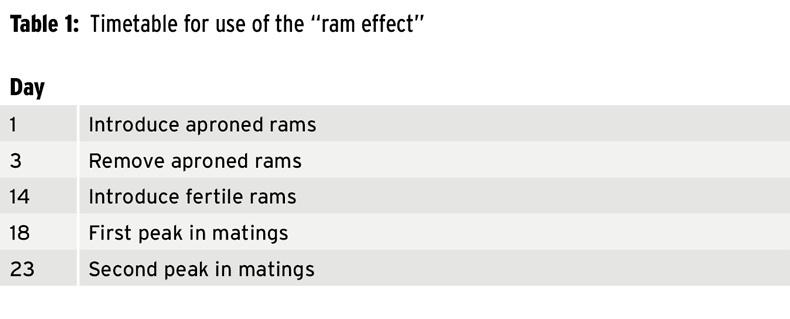
All ewe lambs were raddled by rams during the joining period and the lambing season was compact with 62 and 84% lambing within two and three weeks, respectively. Raddle colour was changed weekly to enable ewes to be penned according to expected lambing date and scanned litter size. When using the “ram effect” to synchronise the mating season it is essential to have an adequate number of rams for mating (one experienced ram per about 35 ewes) and to have adequate facilities (lambing pens – one per five to six ewes) and labour during the lambing season.
Performance of ewe lambs
The effects of ewe genotype on litter size and lamb performance are presented in Table 2. Ewe genotype had a major effect on litter size (difference of 0.39 lambs) and number of lambs reared per ewe joined (0.37 lambs). Belclare ewe lambs reared a similar number of lambs as the mean number of lambs reared per ewe in the national flock.
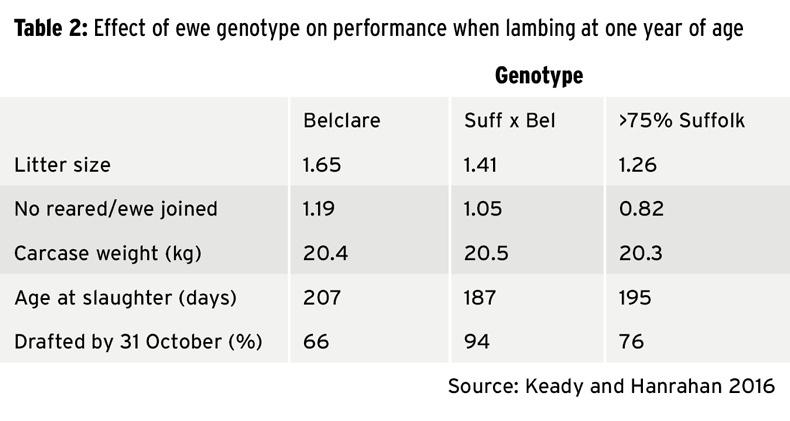
Lamb carcase weight was similar for the three ewe genotypes. Lambs from the Suffolk x Belclare ewes were the youngest at slaughter. By the end of October, 66%, 94% and 76% of lambs from the Belclare, Belclare x Suffolk and >75% Suffolk ewe genotypes had been drafted for slaughter. All lambs had been drafted for slaughter, without any concentrate supplementation post weaning, prior to the end of the grazing season in early December.
Effect of weight at joining
An important part of the current study was to provide information on the effect of weight at joining on the probability of a ewe rearing at least one lamb when lambing at one year of age (Figure 1). The data presented in Figure 1 reflect differences due to ewe and lamb mortality, litter size and ewe barrenness. Regardless of ewe genotype, as weight at joining increased the probability of rearing at least one lamb improved. To have a 0.9 probability (90% chance) of rearing at least one lamb Belclare, Suffolk x Belclare and =75% Suffolk ewe lambs would need to be 48.5kg, 51.2kg and 60kg at joining, respectively. Thus Belclare, Suffolk x Belclare and =75% Suffolk ewe lambs would need to be 63%, 64% and 72% of mature body weight when joining at 7.5 months of age to have a 90% probability of rearing at least one lamb when lambing at one year of age.
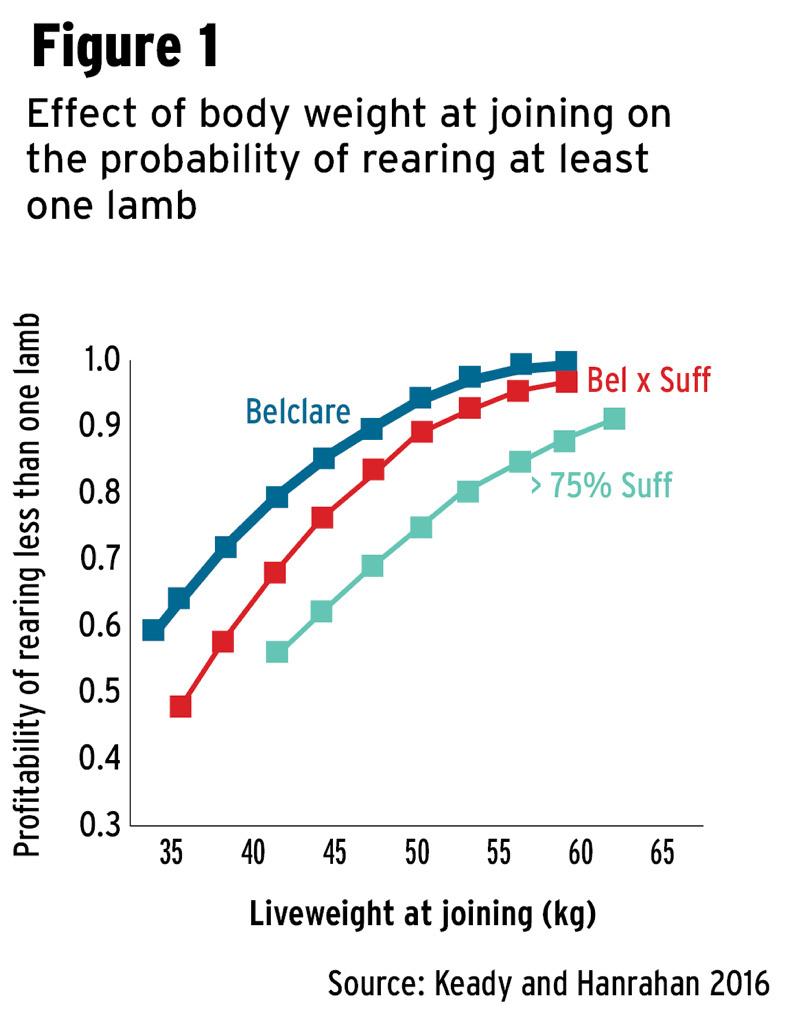
Effect of age at first joining
A question often asked is ‘‘does producing a litter at one year of age affect ewe performance when lambing at two years of age?’’ Ewes that had previously lambed at one year of age were only 2kg lighter at joining at 19 months of age. However, lambing ewes at one year of age had no negative effect on litter size or the number of lambs reared per ewe joined when lambing at two years of age (Table 3). Furthermore, lambing at one year of age had no negative effect on carcase weight or age at slaughter of progeny when lambing at two years of age.
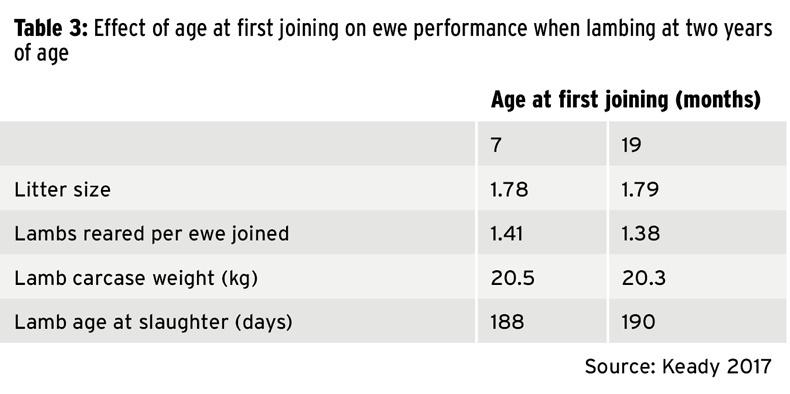
Effects on performance
to four years
In the current study the only lambs reared by two-, three- and four-year-old ewes to receive concentrate supplementation until weaning were those reared as triplets. All lambs were grazed together post-weaning and received no concentrate supplementation prior to slaughter. The effect of ewe genotype on drafting pattern is presented in Figure 2. Ewe genotype did not alter drafting pattern. All lambs were drafted prior to the end of the grazing season.
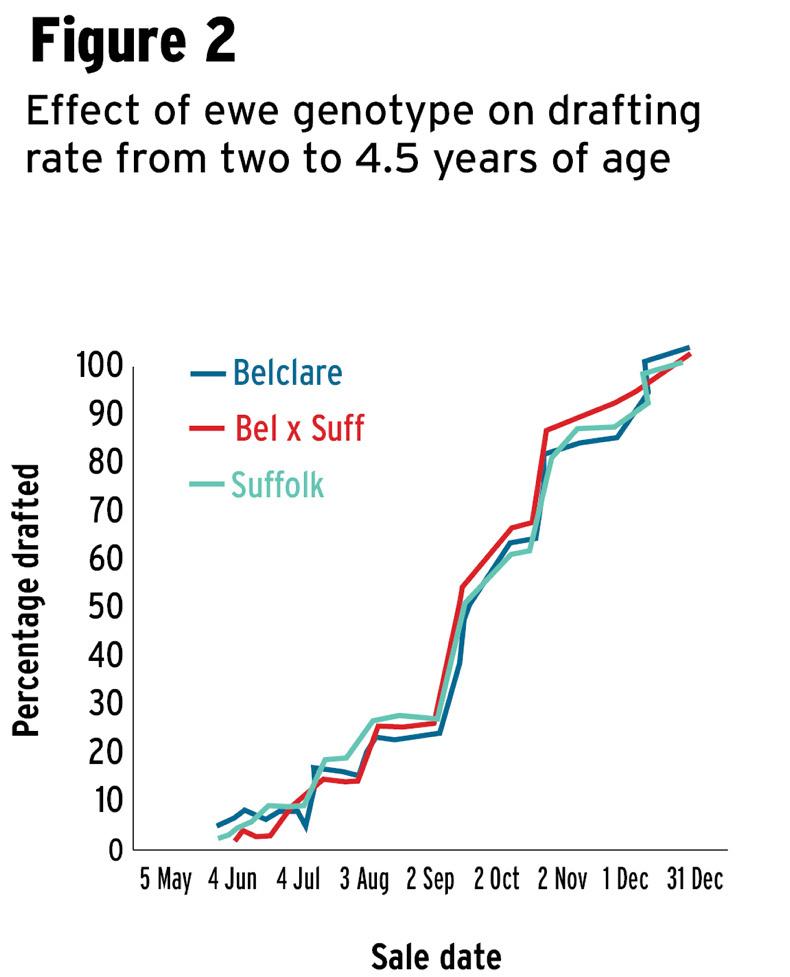
The number of lambs reared during a ewe’s lifetime is a key factor influencing profitability. Ewe genotype and age at first lambing had a big effect on ewe productivity (Table 4). Relative to the >75% Suffolk ewes lambing for the first time at two years, Belclare and Suffolk x Belclare which lambed at one year had reared an extra 1.9 lambs per ewe joined by 4.5 years of age. On average, during years two to four, Belclare and Suffolk x Belclare ewes reared an extra 0.3 lambs/ewe joined per year, relative to the >75% Suffolk ewes. This higher number of lambs reared by the Beclare and Suffolk x Belclare ewes from two to four years of age is equivalent to an extra lamb.
Relative to the >75% Suffolk ewes lambing for the first time at two years, Belclare and Suffolk x Belclare ewes which lambed at one year reared of age had produced an additional 39 kg of lamb carcase weight by four years of age.
The value of the additional carcase weight equates to an increase in net margin of approximately €26/ewe per year. The mean net margin of lowland sheep producers (National Farm Survey), during the past three years, was €9/ewe. The net margin for the top third of sheep producers (National Farm Survey) was €40/ewe. Consequently, lambing ewe replacements at one year of age and increasing ewe prolificacy can significantly increase net margin on lowland sheep farms.
Science to practice
Lambing replacements at one year of age and increasing ewe prolificacy can substantially increase net margin on lowland sheep farms.Replacements which produce their first litter at one year, rear an additional one lamb per ewe joined relative to ewes which produce their first litter at two years of age.Use of the ram effect compacted the lambing season: 62% and 84% of ewes lambed within two and three weeks, respectively.Belclare and Suffolk x Belclare ewes reared an additional 0.9 lambs per ewe joined compared with >75% Suffolk ewes due to their higher prolificacy from two to four years of age.By four years of age, Belclare and Belclare x Suffolk ewes joined to produce their first litter at one year have reared an additional 1.9 lambs per ewe joined relative to >75% Suffolk ewes producing their first litter at two years of age.Dr Tim Keady is principal research officer based at Teagasc, Animal and Grassland Research and Innovation Centre, Mellows Campus, Athenry, Co Galway and Noel McNamara is farm manager at the unit.
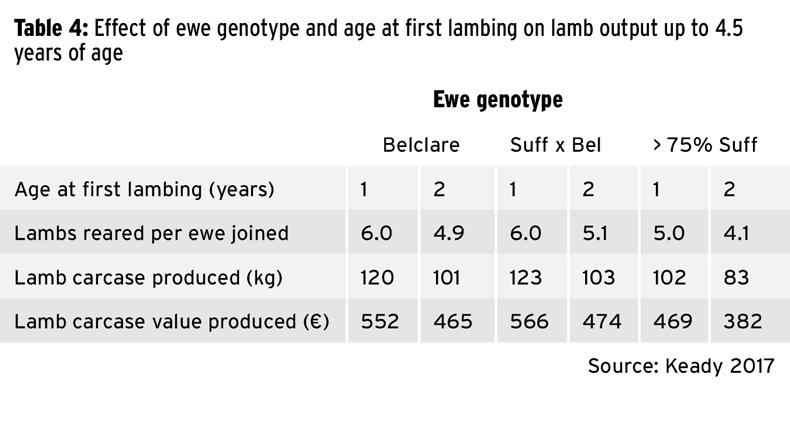
The cost of replacement ewes at joining at approximately 18 months of age is equivalent to 25% of the value of lamb carcase output produced during their lifetime. It is estimated that the ewe replacement rate for the national lowland flock is approximately 22% (National Farm Survey).
Replacement ewes normally join breeding flocks at 18 months of age with the intention of producing their first lambs at 24 months. Two ways of reducing replacement cost are, firstly, to increase longevity and thus the number of litters produced, and, secondly, to increase litter size and thus the number of lambs weaned per ewe joined to the ram.
Athenry study
An ongoing study at Athenry was designed to evaluate the effects of age at first lambing and ewe genotype [=75% Suffolk, Suffolk×Belclare, purebred Belclare] on the lifetime performance of ewes. Suffolk was chosen as over half of the national flock comprise Suffolk types while the Belclare was chosen because of its proven high productivity.
Half of the ewe lambs, within each genotype, were joined with rams to produce their first litter at one year of age while the remainder were joined to produce their first litter at two years of age. To avoid maternal and terminal breed confounding effects and to maximise hybrid vigour in the lambs, Charollais sires were used.
All ewe lambs in this study were managed as one flock from four months of age until time of joining with a ram. Following joining, all ewes were managed as one flock until one month post-housing (early January).
From early January to six weeks prior to lambing, ewe lambs which were joined were offered concentrate supplementation (250g/day) to meet pregnancy requirements and enable the ewes to continue to grow. During the last six weeks of pregnancy, ewes carrying singles, twins and triplets received 18kg, 26kg and 33kg concentrate, respectively.
The ewe lambs that were to be joined for the first time to lamb at two years of age received grass silage as the sole diet during their first winter housing period. When the ewe lambs that lambed at one year of age were weaned (at 15 months) they were managed as one flock with those that had not been joined the previous autumn. At this stage of the study, results from lambing up to four years of age are available for all animals.
Ewe lamb mating management
The “ram effect” can be used to induce ewes and ewe lambs to start cycling provided they are sufficiently close to the time of onset of normal cyclicity. For the “ram effect” to work, the ewes should not have been in contact (sight or smell) with rams for the previous month.
The “ram effect” was used on ewe lambs at Athenry and the procedure used is summarised in Table 1. Fertile rams were introduced to the flock 14 days after the rams used to induce the “ram effect” were first introduced to cover ewes with short cycles and ewes that were already cyclic at the time of ram introduction. Expected peak mating times are four and nine days after fertile ram introduction.

All ewe lambs were raddled by rams during the joining period and the lambing season was compact with 62 and 84% lambing within two and three weeks, respectively. Raddle colour was changed weekly to enable ewes to be penned according to expected lambing date and scanned litter size. When using the “ram effect” to synchronise the mating season it is essential to have an adequate number of rams for mating (one experienced ram per about 35 ewes) and to have adequate facilities (lambing pens – one per five to six ewes) and labour during the lambing season.
Performance of ewe lambs
The effects of ewe genotype on litter size and lamb performance are presented in Table 2. Ewe genotype had a major effect on litter size (difference of 0.39 lambs) and number of lambs reared per ewe joined (0.37 lambs). Belclare ewe lambs reared a similar number of lambs as the mean number of lambs reared per ewe in the national flock.

Lamb carcase weight was similar for the three ewe genotypes. Lambs from the Suffolk x Belclare ewes were the youngest at slaughter. By the end of October, 66%, 94% and 76% of lambs from the Belclare, Belclare x Suffolk and >75% Suffolk ewe genotypes had been drafted for slaughter. All lambs had been drafted for slaughter, without any concentrate supplementation post weaning, prior to the end of the grazing season in early December.
Effect of weight at joining
An important part of the current study was to provide information on the effect of weight at joining on the probability of a ewe rearing at least one lamb when lambing at one year of age (Figure 1). The data presented in Figure 1 reflect differences due to ewe and lamb mortality, litter size and ewe barrenness. Regardless of ewe genotype, as weight at joining increased the probability of rearing at least one lamb improved. To have a 0.9 probability (90% chance) of rearing at least one lamb Belclare, Suffolk x Belclare and =75% Suffolk ewe lambs would need to be 48.5kg, 51.2kg and 60kg at joining, respectively. Thus Belclare, Suffolk x Belclare and =75% Suffolk ewe lambs would need to be 63%, 64% and 72% of mature body weight when joining at 7.5 months of age to have a 90% probability of rearing at least one lamb when lambing at one year of age.

Effect of age at first joining
A question often asked is ‘‘does producing a litter at one year of age affect ewe performance when lambing at two years of age?’’ Ewes that had previously lambed at one year of age were only 2kg lighter at joining at 19 months of age. However, lambing ewes at one year of age had no negative effect on litter size or the number of lambs reared per ewe joined when lambing at two years of age (Table 3). Furthermore, lambing at one year of age had no negative effect on carcase weight or age at slaughter of progeny when lambing at two years of age.

Effects on performance
to four years
In the current study the only lambs reared by two-, three- and four-year-old ewes to receive concentrate supplementation until weaning were those reared as triplets. All lambs were grazed together post-weaning and received no concentrate supplementation prior to slaughter. The effect of ewe genotype on drafting pattern is presented in Figure 2. Ewe genotype did not alter drafting pattern. All lambs were drafted prior to the end of the grazing season.

The number of lambs reared during a ewe’s lifetime is a key factor influencing profitability. Ewe genotype and age at first lambing had a big effect on ewe productivity (Table 4). Relative to the >75% Suffolk ewes lambing for the first time at two years, Belclare and Suffolk x Belclare which lambed at one year had reared an extra 1.9 lambs per ewe joined by 4.5 years of age. On average, during years two to four, Belclare and Suffolk x Belclare ewes reared an extra 0.3 lambs/ewe joined per year, relative to the >75% Suffolk ewes. This higher number of lambs reared by the Beclare and Suffolk x Belclare ewes from two to four years of age is equivalent to an extra lamb.
Relative to the >75% Suffolk ewes lambing for the first time at two years, Belclare and Suffolk x Belclare ewes which lambed at one year reared of age had produced an additional 39 kg of lamb carcase weight by four years of age.
The value of the additional carcase weight equates to an increase in net margin of approximately €26/ewe per year. The mean net margin of lowland sheep producers (National Farm Survey), during the past three years, was €9/ewe. The net margin for the top third of sheep producers (National Farm Survey) was €40/ewe. Consequently, lambing ewe replacements at one year of age and increasing ewe prolificacy can significantly increase net margin on lowland sheep farms.
Science to practice
Lambing replacements at one year of age and increasing ewe prolificacy can substantially increase net margin on lowland sheep farms.Replacements which produce their first litter at one year, rear an additional one lamb per ewe joined relative to ewes which produce their first litter at two years of age.Use of the ram effect compacted the lambing season: 62% and 84% of ewes lambed within two and three weeks, respectively.Belclare and Suffolk x Belclare ewes reared an additional 0.9 lambs per ewe joined compared with >75% Suffolk ewes due to their higher prolificacy from two to four years of age.By four years of age, Belclare and Belclare x Suffolk ewes joined to produce their first litter at one year have reared an additional 1.9 lambs per ewe joined relative to >75% Suffolk ewes producing their first litter at two years of age.Dr Tim Keady is principal research officer based at Teagasc, Animal and Grassland Research and Innovation Centre, Mellows Campus, Athenry, Co Galway and Noel McNamara is farm manager at the unit.








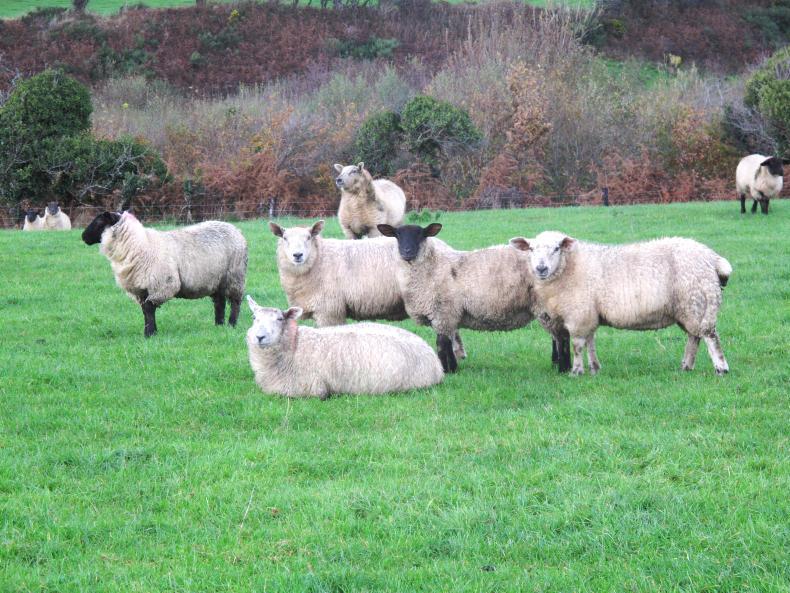




 This is a subscriber-only article
This is a subscriber-only article













SHARING OPTIONS: